Mitigating Spatial Discontinuity of Multi-Radar QPE Based on GPM/KuPR
Abstract
1. Introduction
2. Data Sources
2.1. Ground Radar Data
2.2. Rain Measurement Data
2.3. GPM/KuPR Data
3. Methodology
3.1. Hypotheses of M-ABCD
3.2. Details of M-ABCD Method
4. Results
4.1. Effectiveness of STEP3–STEP6
4.2. Corrected Reflectivity Distribution
4.3. Spatial Continuity of Reflectivity Factor
4.4. Spatial Continuity of MGR-QPE
4.5. Accuracy of MGR-QPE
5. Summary and Discussion
Author Contributions
Funding
Acknowledgments
Conflicts of Interest
References
- Gou, Y.; Ma, Y.; Chen, H.; Wen, Y. Radar-derived Quantitative Precipitation Estimation in Complex Terrain over the Eastern Tibetan Plateau. Atmos. Res. 2018, 203, 286–297. [Google Scholar] [CrossRef]
- Wilson, J.W.; Brandes, E.A. Radar Measurement of Rainfall—A Summary. Bull. Am. Meteorol. Soc. 1979, 60, 1048–1058. [Google Scholar] [CrossRef]
- Zhang, J.; Qi, Y.; Kingsmill, D.; Howard, K. Radar-Based Quantitative Precipitation Estimation for the Cool Season in Complex Terrain: Case Studies from the NOAA Hydrometeorology Testbed. J. Hydrometeorol. 2012, 13, 1836–1854. [Google Scholar] [CrossRef]
- Ulbrich, C.W.; Lee, L.G. Rainfall Measurement Error by WSR-88D Radars due to Variations in Z–R Law Parameters and the Radar Constant. J. Atmos. Ocean Technol. 1999, 16, 1017–1024. [Google Scholar] [CrossRef]
- Rosenfeld, D.; Ulbrich, C.W. Cloud Microphysical Properties, Processes, and Rainfall Estimation Opportunities. In Radar and Atmospheric Science: A Collection of Essays in Honor of David Atlas; Wakimoto, R.M., Srivasva, R.C., Eds.; Springer: Berlin, Germany, 2003; pp. 237–258. [Google Scholar]
- Seo, B.-C.; Cunha, L.K.; Krajewski, W.F. Uncertainty in Radar-Rainfall Composite and its Impact on Hydrologic Prediction for the Eastern Iowa Flood of 2008. Water Resour. Res. 2013, 49, 2747–2764. [Google Scholar] [CrossRef]
- Brandes, E.A.; Vivekanandan, J.; Wilson, J.W. A Comparison of Radar Reflectivity Estimates of Rainfall from Collocated Radars. J. Atmos. Ocean. Technol. 1999, 16, 1264–1272. [Google Scholar] [CrossRef]
- Smith, J.A.; Seo, D.J.; Baeck, M.L.; Hudlow, M.D. An Intercomparison Study of NEXRAD Precipitation Estimates. Water Resour. Res. 1996, 32, 2035–2045. [Google Scholar] [CrossRef]
- Gourley, J.J.; Kaney, B.; Maddox, R.A. Evaluating the Calibration of Radars: A Software Approach. In Proceedings of the 31st International Conference on Radar Meteorology, Seattle, WA, USA, 5–12 August 2003. P3C.1. [Google Scholar]
- You, C.H.; Kang, M.Y.; Lee, D.I.; Lee, J.T. Approaches to Radar Reflectivity Bias Correction to Improve Rainfall Estimation in Korea. Atmos. Meas. Tech. 2016, 9, 2043–2053. [Google Scholar] [CrossRef]
- Xiao, Y.; Liu, L. Study of Methods for Interpolating Data from Weather Radar Network to 3-D Grid and Mosaics (in Chinese). Acta Meteorol. Sin. 2006, 64, 647–657. [Google Scholar] [CrossRef]
- Doviak, R.J.; Zrnic, D.S. Doppler Radar and Weather Observations; Academic Press: Cambridge, MA, USA, 1993; 562p. [Google Scholar]
- Atlas, D. Radar Calibration: Some Simple Approaches. Bull. Am. Meteorol. Soc. 2002, 83, 1313–1316. [Google Scholar] [CrossRef]
- Vaccarono, M.; Bechini, R.; Chandrasekar, C.V.; Cremonini, R.; Cassardo, C. An Integrated Approach to Monitoring the Calibration Stability of Operational Dual-Polarization Radars. Atmos. Meas. Tech. 2016, 9, 5367–5383. [Google Scholar] [CrossRef]
- Kozu, T.; Kawanishi, T.; Kuroiwa, H.; Kojima, M.; Oikawa, K.; Kumagai, H.; Okamoto, K.; Okumura, M.; Nakatsuka, H.; Nishikawa, K. Development of Precipitation Radar Onboard the Tropical Rainfall Measuring Mission (TRMM) Satellite. IEEE Trans. Geosci. Remote Sens. 2001, 39, 102–116. [Google Scholar] [CrossRef]
- Takahashi, N.; Kuroiwa, H.; Kawanishi, T. Four Year Result of External Calibration for Precipitation Radar (PR) of the Tropical Rainfall Measuring Mission (TRMM) Satellite. IEEE Trans. Geosci. Remote Sens. 2003, 41, 2398–2403. [Google Scholar] [CrossRef]
- Kim, J.; Ou, M.; Park, J.; Morris, K.R.; Schwaller, M.R.; Wolff, D.B. Global Precipitation Measurement (GPM) Ground Validation (GV) Prototype in the Korean Peninsula. J. Atmos. Ocean. Technol. 2014, 31, 1902–1921. [Google Scholar] [CrossRef]
- Han, J.; Chu, Z.; Wang, Z.; Xu, D.; Li, N.; Kou, L.; Xu, F.; Zhu, Y. The Establishment of Optimal Ground-Based Radar Datasets by Comparison and Correlation Analyses with Space-Borne Radar Data. Meteorol. Appl. 2017, 25, 161–170. [Google Scholar] [CrossRef]
- Liao, L.; Meneghini, R.; Iguchi, T. Comparisons of Rain Rate and Reflectivity Factor Derived from the TRMM Precipitation Radar and the WSR-88D over the Melbourne, Florida, Site. J. Atmos. Ocean. Technol. 2001, 18, 1959–1974. [Google Scholar] [CrossRef]
- Liao, L.; Meneghini, R. Validation of TRMM Precipitation Radar through Comparison of Its Multiyear Measurements with Ground-Based Radar. J. Appl. Meteorol. Climatol. 2009, 48, 804–817. [Google Scholar] [CrossRef]
- Anagnostou, E.N.; Morales, C.A.; Dinku, T. The Use of TRMM Precipitation Radar Observations in Determining Ground Radar Calibration Biases. J. Atmos. Ocean. Technol. 2001, 18, 616–628. [Google Scholar] [CrossRef]
- Wang, J.X.; Wolff, D.B. Comparisons of Reflectivities from the TRMM Precipitation Radar and Ground-Based Radars. J. Atmos. Ocean. Technol. 2009, 26, 857–875. [Google Scholar] [CrossRef]
- Chu, Z.; Yin, Y.; Gu, S. Characteristics of Velocity Ambiguity for CINRAD-SA Doppler Weather Radars. Asia-Pac. J. Atmos. Sci. 2014, 50, 221–227. [Google Scholar] [CrossRef]
- Wu, T.; Wan, Y.; Wo, W.; Leng, L. Design and Application of Radar Reflectivity Quality Control Algorithm in SWAN (in Chinese). Meteorol. Sci. Technol. 2013, 41, 809–817. [Google Scholar] [CrossRef]
- Tokay, A.; Wolff, D.B.; Petersen, W.A. Evaluation of the New Version of Laser-Optical Disdrometer, OTT Parsivel2. J. Atmos. Ocean. Technol. 2014, 31, 1276–1288. [Google Scholar] [CrossRef]
- Shen, Y.; Xiong, A. Validation and Comparison of a New Gauge-Based Precipitation Analysis over Mainland China. Int. J. Climatol. 2016, 36, 252–265. [Google Scholar] [CrossRef]
- Hou, A.Y.; Kakar, R.K.; Neeck, S.; Azarbarzin, A.A.; Kummerow, C.D.; Kojima, M.; Oki, R.; Nakamura, K.; Iguchi, T. The Global Precipitation Measurement Mission. Bull. Am. Meteor. Soc. 2014, 95, 701–722. [Google Scholar] [CrossRef]
- Meneghini, R.; Kim, H.; Liao, L.; Jones, J.A.; Kwiatkowski, J.M. An Initial Assessment of the Surface Reference Technique Applied to Data from the Dual-Frequency Precipitation Radar (DPR) on the GPM Satellite. J. Atmos. Ocean. Technol. 2015, 32, 2281–2296. [Google Scholar] [CrossRef]
- Seto, S.; Iguchi, T. Intercomparison of Attenuation Correction Methods for the GPM Dual-Frequency Precipitation Radar. J. Atmos. Ocean. Technol. 2015, 32, 915–926. [Google Scholar] [CrossRef]
- Iguchi, T.; Kozu, T.; Meneghini, R.; Awaka, J.; Okamoto, K. Rain-Profiling Algorithm for the TRMM Precipitation Radar. J. Appl. Meteorol. 2000, 39, 2038–2052. [Google Scholar] [CrossRef]
- Iguchi, T.; Seto, S.; Awaka, J.; Meneghini, R.; Kubota, T. Performance of the Dual-frequency Precipitation Radar on the GPM core satellite. Geophys. Res. Abstr. 2016, 18, 11581. [Google Scholar]
- Bringi, V.N.; Chandrasekar, V.; Hubbert, J.; Gorgucci, E.; Randeu, W.L.; Schoenhuber, M. Raindrop Size Distribution in Different Climatic Regimes from Disdrometer and Dual-Polarized Radar Analysis. J. Atmos. Sci. 2003, 60, 354–365. [Google Scholar] [CrossRef]
- Cao, Q.; Zhang, G. Errors in Estimating Raindrop Size Distribution Parameters Employing Disdrometer and Simulated Raindrop Spectra. J. Appl. Meteorol. Clim. 2009, 48, 406–425. [Google Scholar] [CrossRef]
- Waterman, P.C. Matrix Formulation of Electromagnetic Scattering. Proc. IEEE 1965, 53, 805–812. [Google Scholar] [CrossRef]
- Mishchenko, M.I.; Travis, L.D.; Mackowski, D.W. T-Matrix Computations of Light Scattering by Nonspherical Particles: A review. J. Quant. Spectrosc. Radiat. Transf. 1996, 55, 535–575. [Google Scholar] [CrossRef]
- Beard, K.V.; Chuang, C. A New Model for The Equilibrium Shape of Raindrops. J. Atmos. Sci. 1987, 44, 1509–1524. [Google Scholar] [CrossRef]
- Kalogiros, J.; Anagnostou, M.N.; Anagnostou, E.N.; Montopoli, M.; Picciotti, E.; Marzano, F.S. Optimum Estimation of Rain Microphysical Parameters from X-band Dual-Polarization Radar Observables. IEEE Trans. Geosci. Remote Sens. 2013, 51, 3063–3076. [Google Scholar] [CrossRef]
- Awaka, J.; Le, M.D.; Chandrasekar, V.; Yoshida, N.; Higashiuwatoko, T.; Kubota, T.; Iguchi, T. Rain Type Classification Algorithm Module for GPM Dual-Frequency Precipitation Radar. J. Atmos. Ocean. Technol. 2016, 33, 1887–1898. [Google Scholar] [CrossRef]
- Liao, L.; Meneghini, R. Changes in the TRMM Version-5 and Version-6 Precipitation Radar Products due to Orbit Boost. J. Meteorol. Soc. Jpn. 2009, 87, 93–107. [Google Scholar] [CrossRef]
- Le, M.; Chandrasekar, V.; Biswas, S. Evaluation and Validation of GPM Dual-Frequency Classification Module after Launch. J. Atmos. Ocean. Technol. 2016, 33, 2699–2716. [Google Scholar] [CrossRef]
- Seo, B.-C.; Krajewski, W.F.; Smith, J.A. Four-Dimensional Reflectivity Data Comparison between Two Ground-Based Radars: Methodology and Statistical Analysis. Hydrol. Sci. J. 2014, 59, 1312–1326. [Google Scholar] [CrossRef]
- Cressman, G.P. An Operational Objective Analysis System. Mon. Weather Rev. 1959, 81, 367–374. [Google Scholar] [CrossRef]
- Schwaller, M.R.; Morris, K.R. A Ground Validation Network for the Global Precipitation Measurement Mission. J. Atmos. Ocean. Technol. 2011, 28, 301–319. [Google Scholar] [CrossRef]
- Derin, Y.; Anagnostou, E.N.; Anagnostou, M.N.; Kalogiros, J.; Casella, D.; Marra, A.C.; Panegrossi, G.; Sanò, P. Passive Microwave Rainfall Error Analysis using High-Resolution X-band Dual-Polarization Radar Observations in Complex Terrain. IEEE Trans. Geosci. Remote Sens. 2018, 56, 2565–2586. [Google Scholar] [CrossRef]
- Bolen, S.M.; Chandrasekar, V. Quantitative Cross Validation of Space-based and Ground-based Radar Observations. J. Appl. Meteorol. 2000, 39, 2071–2079. [Google Scholar] [CrossRef]
- Park, S.; Jung, S.; Lee, G. Cross-validation of TRMM PR Reflectivity Profiles Using 3-D Reflectivity Composite from the Ground-Based Radar Network over the Korean Peninsula. J. Hydrometeorol. 2015, 16, 668–687. [Google Scholar] [CrossRef]
- Marshall, J.S.; Hitschfeld, W.; Gunn, K.L.S. Advances in Radar Weather. Adv. Geophys. 1955, 2, 1–56. [Google Scholar] [CrossRef]
- Zhang, J.; Howard, K.; Langston, C.; Vasiloff, S.; Kaney, B.; Arthur, A.; Cooten, S.V.; Kelleher, K.; Kitzmiller, D.; Ding, F.; et al. National Mosaic and Multi-Sensor QPE (NMQ) System: Description, Results, and Future Plans. Bull. Am. Meteorol. Soc. 2011, 92, 1321–1338. [Google Scholar] [CrossRef]
- Hong, Y.; Gourley, J.J. Radar Hydrology: Principles, Models, and Applications, 1st ed.; CRC Press: Boca Raton, FL, USA, 2014; pp. 17–19. [Google Scholar]
- Ryzhkov, A.V.; Giangrande, S.E.; Melnikov, V.M. Calibration Issues of Dual-Polarization Radar Measurements. J. Atmos. Ocean. Technol. 2005, 22, 1138–1155. [Google Scholar] [CrossRef]
- Kalogiros, J.; Anagnostou, M.N.; Anagnostou, E.N.; Montopoli, M.; Picciotti, E.; Marzano, F.S. Evaluation of a New Polarimetric Algorithm for Rain-Path Attenuation Correction of X-Band Radar Observations Against Disdrometer. IEEE Trans. Geosci. Remote Sens. 2014, 52, 1369–1380. [Google Scholar] [CrossRef]

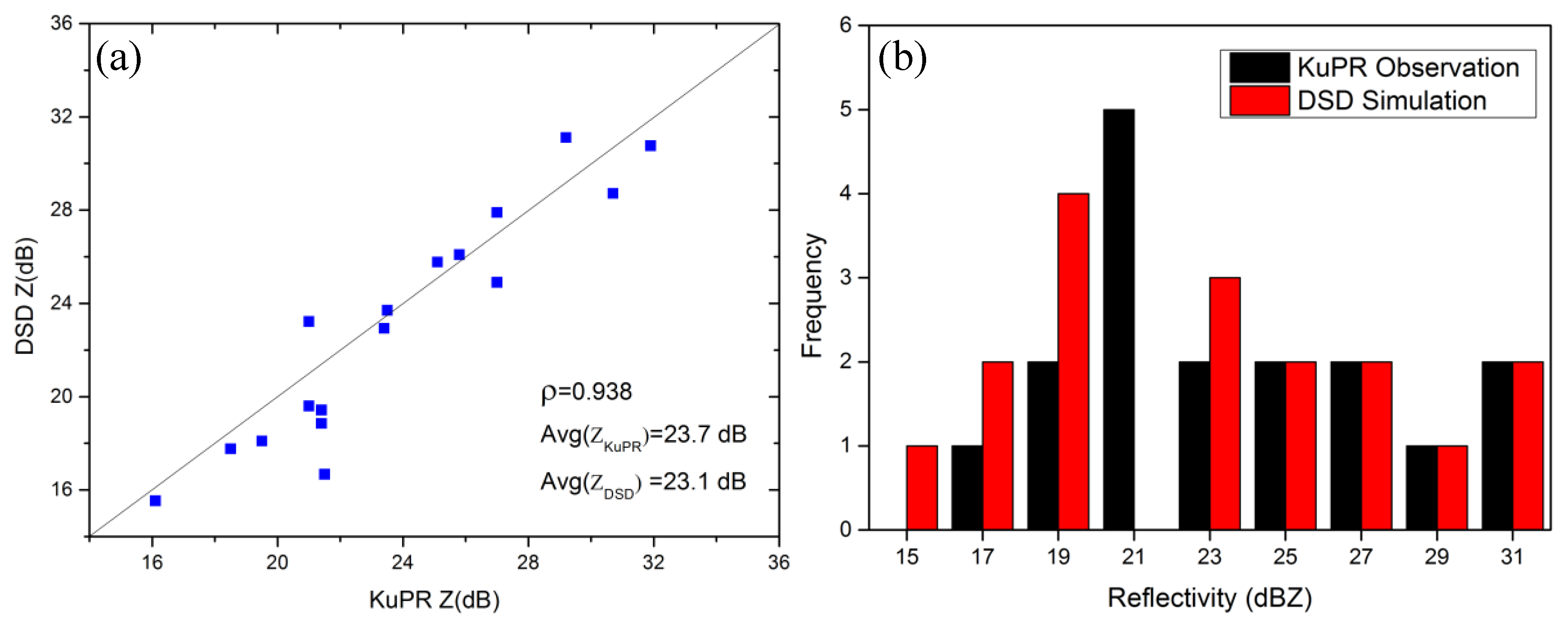
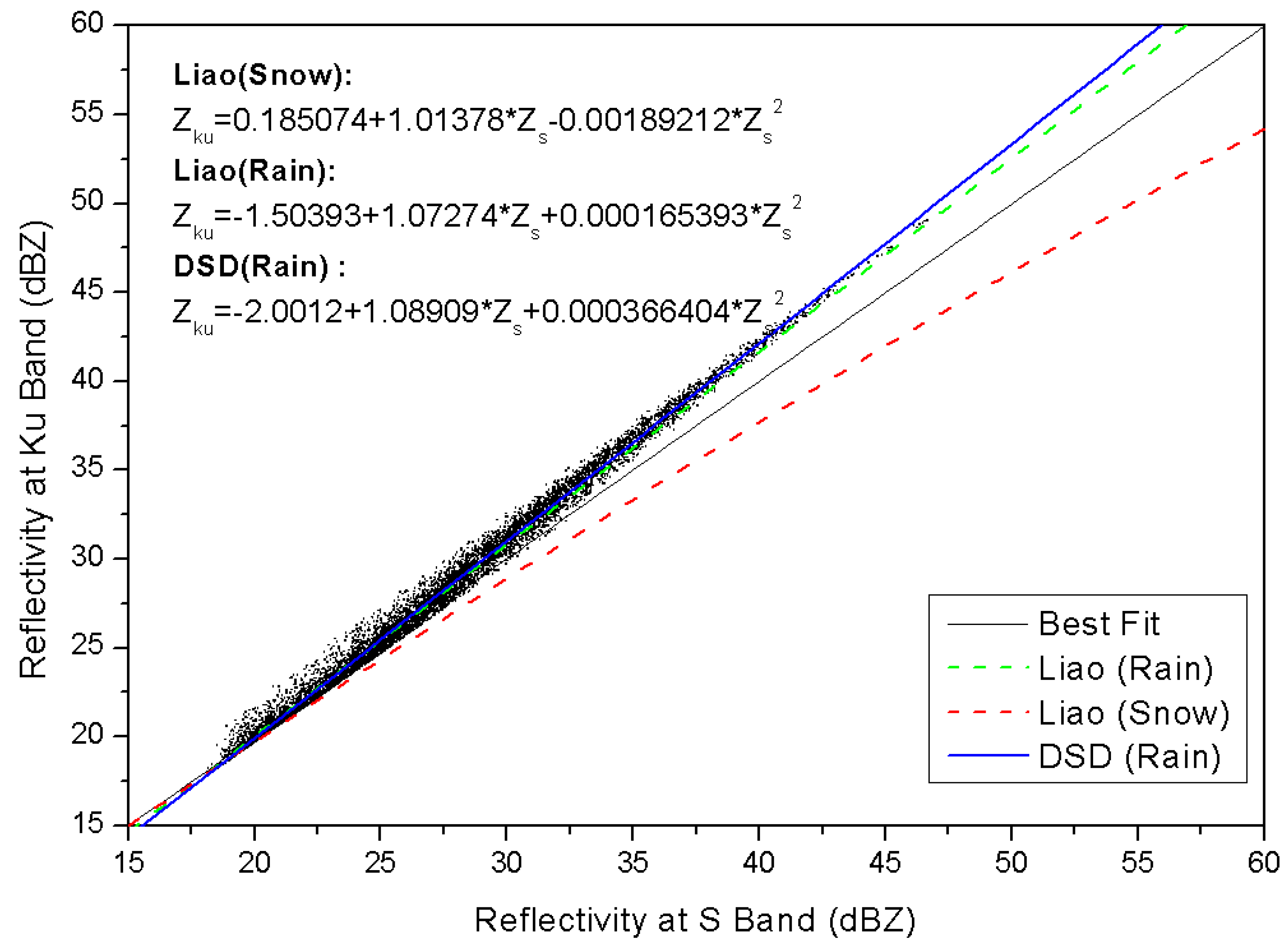
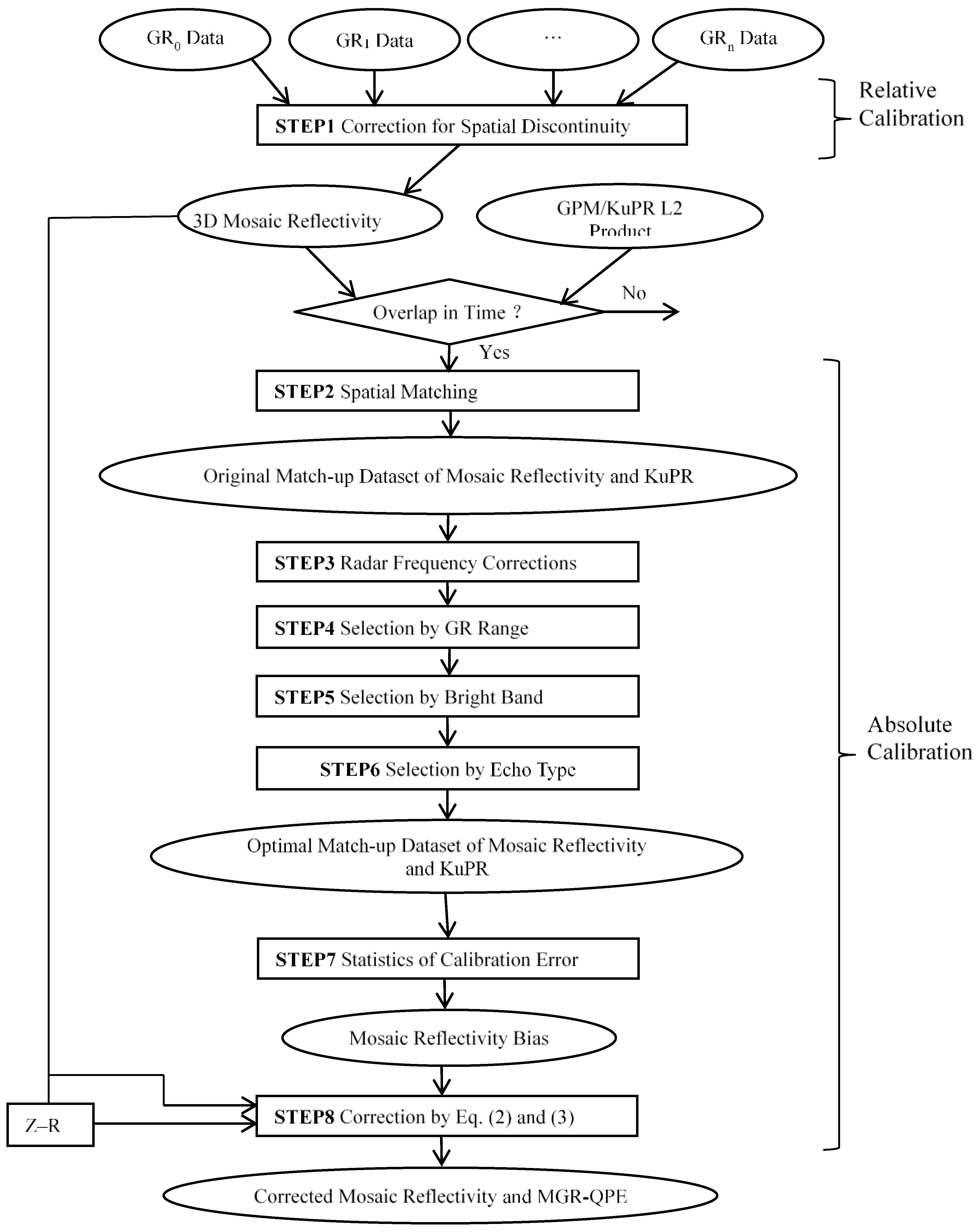
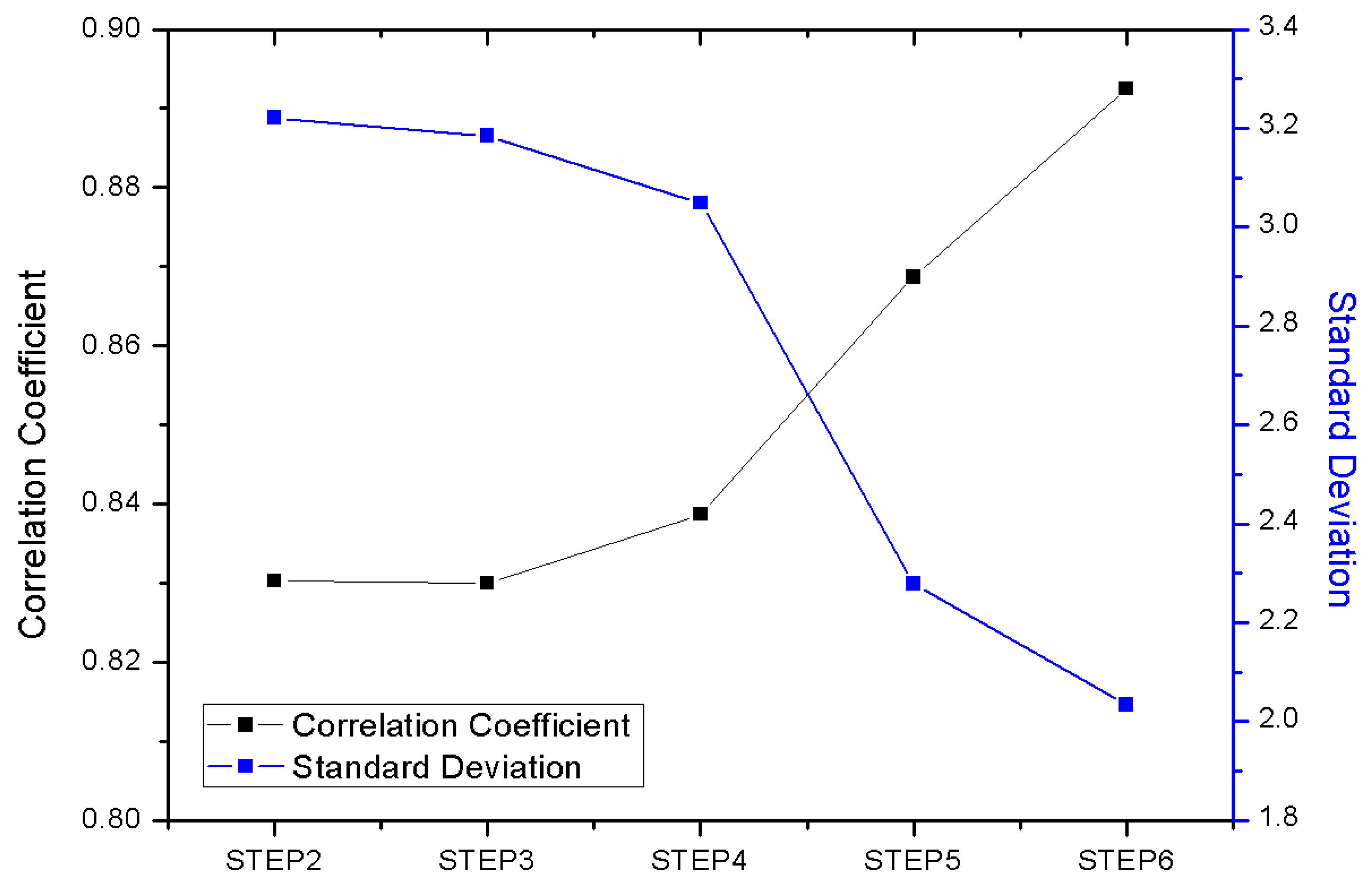
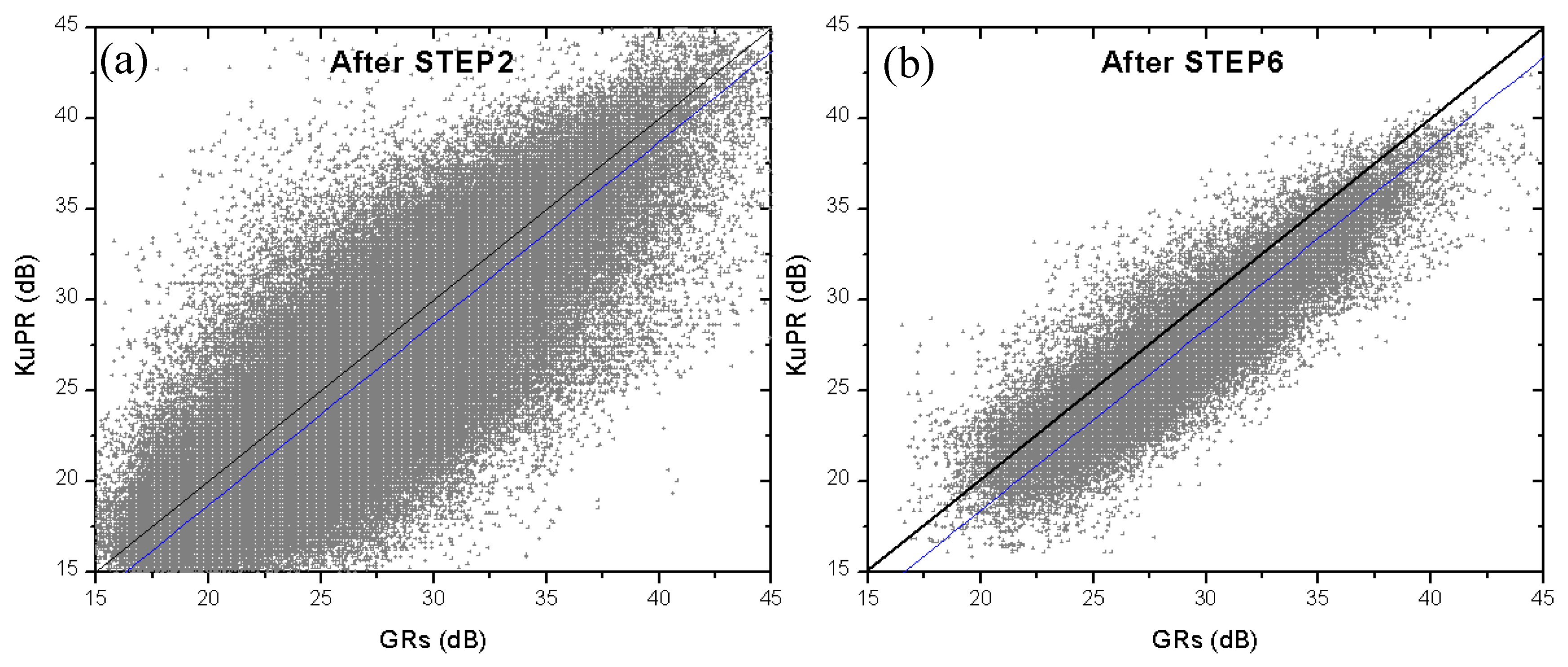
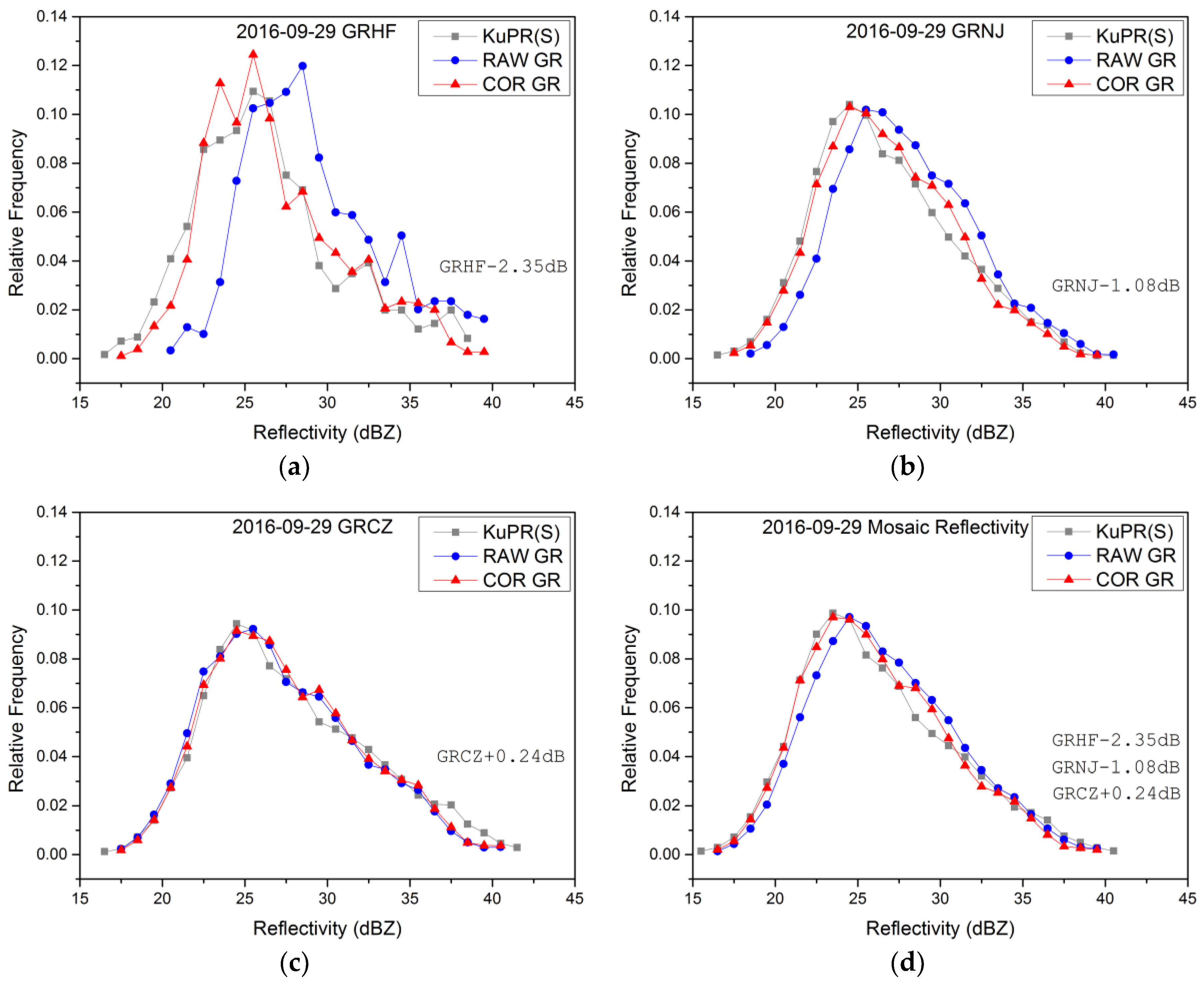
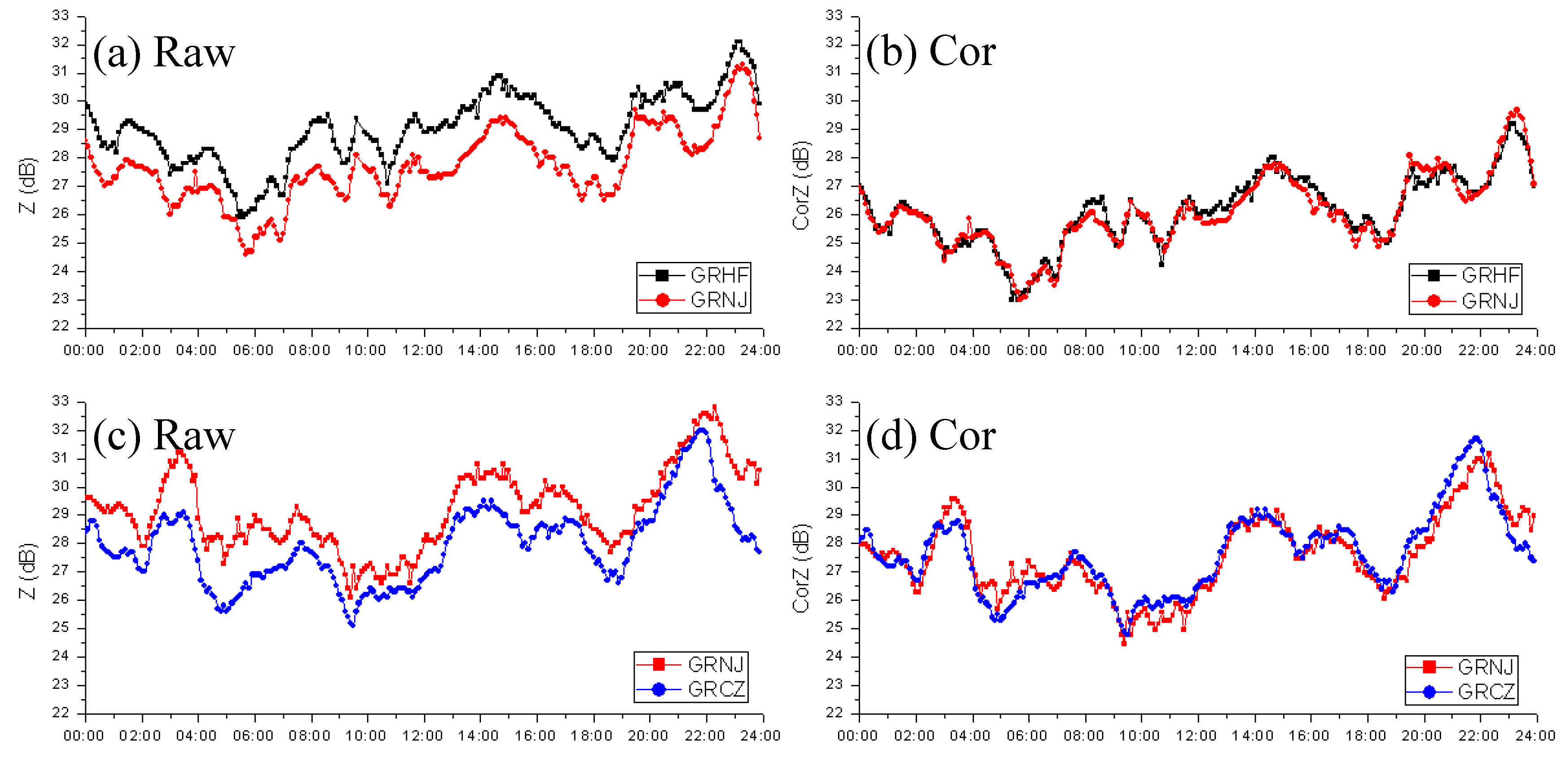

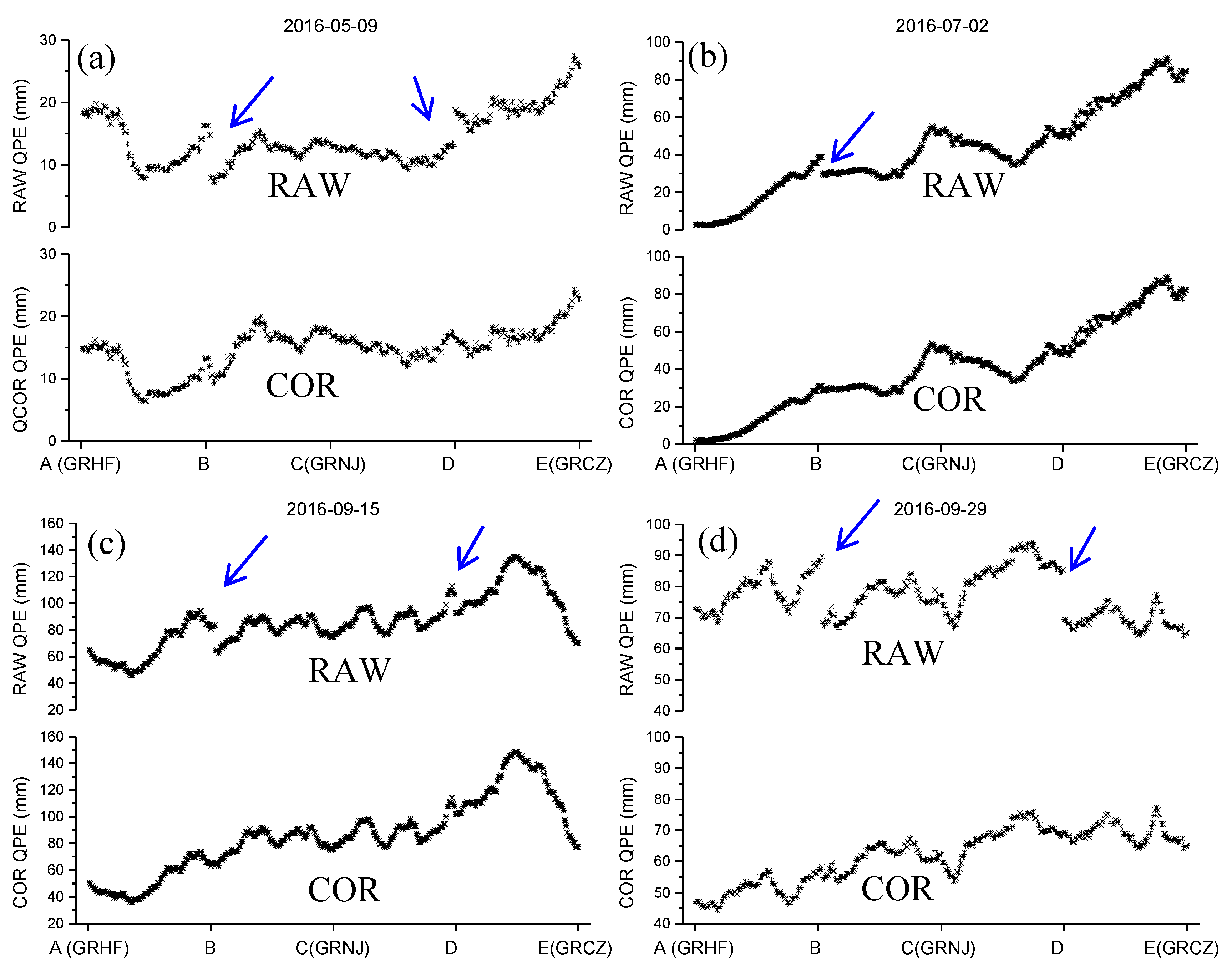
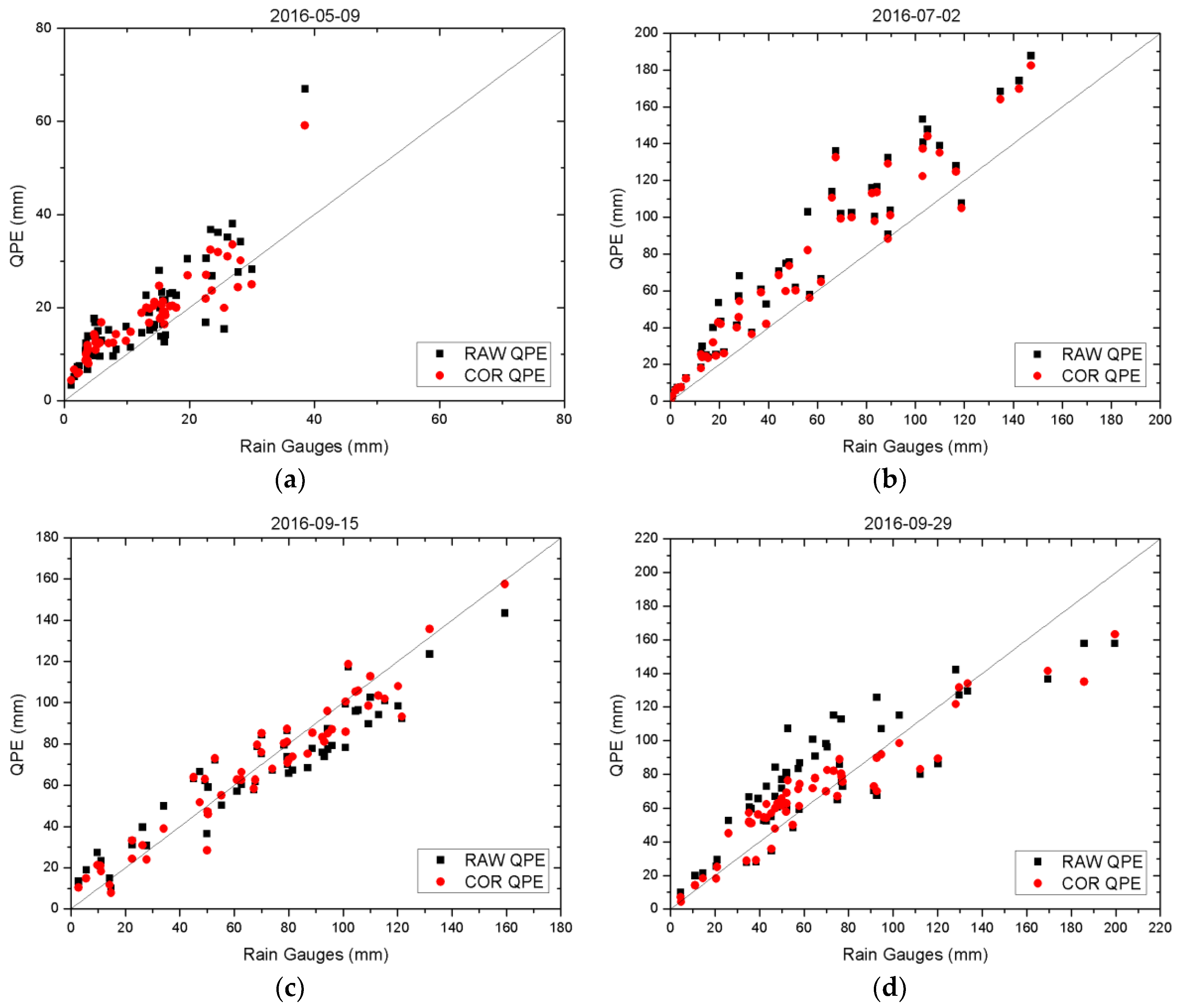
| Date/No. | Rain Type | Z Difference (dB) | ||
|---|---|---|---|---|
| |GRHF-GRNJ| | |GRCZ-GRNJ| | |||
| 05-09 | Light Rain | RAW | 3.29 | 2.69 |
| COR | 0.26 | 0.25 | ||
| 07-02 | Mei-yu | RAW | 1.40 | 0.40 |
| COR | 0.42 | 0.40 | ||
| 09-15 | Typhoon | RAW | 1.84 | 0.73 |
| COR | 0.34 | 0.47 | ||
| 09-29 | Frontal Heavy Rain | RAW | 1.33 | 1.25 |
| COR | 0.25 | 0.46 | ||
| Average | RAW | 1.62 | ||
| COR | 0.36 | |||
| Date/No. | Data Type | 24h QPE Difference (mm) | |
|---|---|---|---|
| |GRHF-GRNJ| | |GRCZ-GRNJ| | ||
| 05-09 | RAW | 6.7 | 3.9 |
| COR | 2.4 | 0.9 | |
| 07-02 | RAW | 6.9 | 0.1 |
| COR | 1.3 | 0.1 | |
| 09-15 | RAW | 13.9 | 12.2 |
| COR | 1.3 | 5.7 | |
| 09-29 | RAW | 19.9 | 16.4 |
| COR | 2.2 | 0.1 | |
| Average | RAW | 10.0 | |
| COR | 1.8 | ||
| Date/No. | Data Type | <Rain Gauge> (mm) | <QPE> (mm) | Correlation Coefficient | NE | RMSE (mm) |
|---|---|---|---|---|---|---|
| 05-09 | RAW | 13.3 | 18.7 | 0.85 | 0.47 | 7.8 |
| COR | 18.2 | 0.91 | 0.41 | 6.2 | ||
| 07-02 | RAW | 53.4 | 74.3 | 0.95 | 0.40 | 26.8 |
| COR | 70.0 | 0.96 | 0.32 | 22.1 | ||
| 09-15 | RAW | 69.5 | 67.1 | 0.94 | 0.16 | 13.1 |
| COR | 68.9 | 0.96 | 0.11 | 9.9 | ||
| 09-29 | RAW | 65.5 | 75.8 | 0.86 | 0.30 | 23.6 |
| COR | 67.7 | 0.94 | 0.18 | 15.6 |
© 2018 by the authors. Licensee MDPI, Basel, Switzerland. This article is an open access article distributed under the terms and conditions of the Creative Commons Attribution (CC BY) license (http://creativecommons.org/licenses/by/4.0/).
Share and Cite
Chu, Z.; Ma, Y.; Zhang, G.; Wang, Z.; Han, J.; Kou, L.; Li, N. Mitigating Spatial Discontinuity of Multi-Radar QPE Based on GPM/KuPR. Hydrology 2018, 5, 48. https://doi.org/10.3390/hydrology5030048
Chu Z, Ma Y, Zhang G, Wang Z, Han J, Kou L, Li N. Mitigating Spatial Discontinuity of Multi-Radar QPE Based on GPM/KuPR. Hydrology. 2018; 5(3):48. https://doi.org/10.3390/hydrology5030048
Chicago/Turabian StyleChu, Zhigang, Yingzhao Ma, Guifu Zhang, Zhenhui Wang, Jing Han, Leilei Kou, and Nan Li. 2018. "Mitigating Spatial Discontinuity of Multi-Radar QPE Based on GPM/KuPR" Hydrology 5, no. 3: 48. https://doi.org/10.3390/hydrology5030048
APA StyleChu, Z., Ma, Y., Zhang, G., Wang, Z., Han, J., Kou, L., & Li, N. (2018). Mitigating Spatial Discontinuity of Multi-Radar QPE Based on GPM/KuPR. Hydrology, 5(3), 48. https://doi.org/10.3390/hydrology5030048





